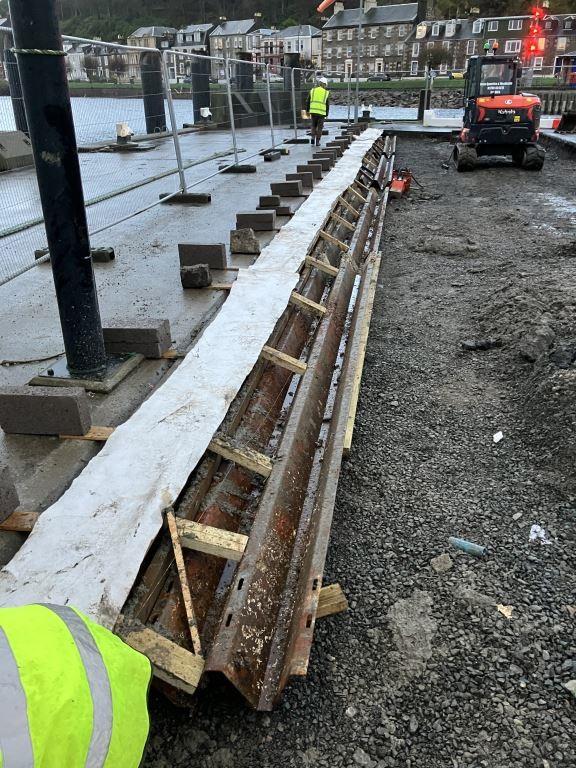16 December 2024.
The current situation
Rothesay Harbour stabilisation work completed this week well ahead of schedule and on budget.
Estimated to finish in February 2025, the project wound up on Friday 20 December.
The £1.9m works, carried out by Shearwater Marine Services, will support the future of the pier by enabling it to accommodate the larger, more powerful vessels than the pier was original built to withstand.
Local quarry – Ambrisbeg - supplied concrete and carried out the re-surfacing works on the pier deck and linkspan access road.

Preparing the deck for its new surface.

The reclaimed timbers sent for recycling locally.
Previous work
The contractor started work, on site, on 27 May as planned and compounds were set up on the main Rothesay Harbour pier and the Albert Pier, to receive material deliveries. Plant and equipment, including a crane and barge, were delivered to the site.
Rock armour consolidation was completed, and the dive inspections made to check the work.
Work was undertaken to build the toe wall at the foot of the original harbour wall. This is to prevent any further loss of seabed material from around the base of the original wall and protect the wall against wave and wash from vessels using the harbour.
The first section of toe wall was between the two areas of rock armour that were consolidated. Work involved digging a trench to place bolster bags in. These bags were filled with concrete and tied together using reinforcing bars. The wall was built in steps, allowing each layer of concrete to harden before the next layer was placed.
The skilled construction divers had to move carefully when filling the bolster bags and be careful not to tear them. A difficult job whilst working beneath the water.
Our diving team then worked beneath the linkspan to construct the final section of wall in that area. Next, they moved over to the current overnight berth area to construct the final section of wall. At that stage, the ferry moved to the front berth nearer the building to allow the divers access.
The team made good use of the calm weather conditions to work quickly. There was potential, as work moved into autumn and winter, for disruption to the work especially if weather conditions are particularly windy or wave swell increased.

Diagram shows progress of work up to October 2024. Concrete consolidation shown in green - complete. First area of toe wall construction shown in orange - complete. Second area of toe wall construction shown in yellow.
The final work carried out was to resurface parts of the pier that had experienced significant settlement.
Background
Works at Rothesay Harbour will support the future of the pier by preparing it to accommodate larger, more powerful vessels than the original pier was built to withstand.
Argyll and Bute Council has appointed Shearwater Marine Ltd to undertake £1.9m stabilisation works at Rothesay Harbour. Maintaining ports and harbours is just one of the services our council provides that others don’t need to.
The contractor will mobilise at the harbour during the week beginning 20 May and the first dive is scheduled to take place on Monday 27 May
Shearwater Marine Ltd will carry out work overnight to minimise disruption to ferry operations and day-to-day travel for Bute residents and visitors should be mainly unaffected.
However, to allow the contractor access to the site, the berth will not be available overnight. This will mean one of the Bute ferries will berth overnight in Gourock.
Work should take nine months to complete, and this is dependent on the weather and supply of materials.
Stabilisation works at the harbour include:
- Constructing a toe (retaining) wall at the base of the original wall to provide stability to the main harbour structure. This will extend 143m from the eastern edge of the harbour wall to the overnight ferry berth
- The toe wall will prevent any potential sliding or further loss of fine materials from the sea bed behind the original wall.
- Repair to the surface of the harbour where there has been visible settlement.
This new work builds on previous investment at the harbour to minimise scour, and so mitigate damage done by vessels over the years. Scour is when the seabed is dug out by vessels moving the water and creating channels against the harbour wall. We fitted a wavescreen which prevents vessels moving the water and creating scour and so protects the harbour wall. Since the wavescreen was fitted, we have seen a notable reduction of settlement on the top of the harbour wall.
For information on revised ferry timetables visit the CalMac website.


